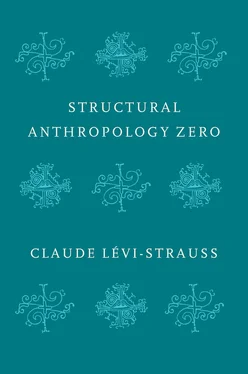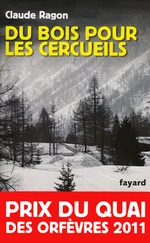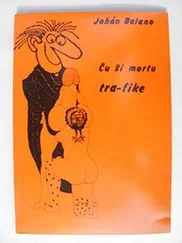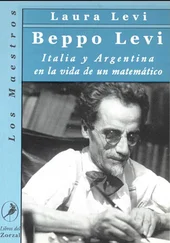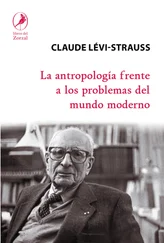This collection is organized into five non-chronological parts. Indeed, the only chronology we might have relied on is that of the official publication dates of the articles it comprises. And in those troubled years, and over such a brief period of time, this could not be expected to have revealed much, either about their actual date of publication or that of their composition or conception. A thematic organization suggested itself for two additional reasons: first, to remain faithful to the “structural anthropologies” model, as Lévi-Strauss himself had conceived it for his own volumes; and, second, to avoid the assembled articles being received as mere “heritage.” For the point was not to collect the juvenilia of a great author or to shed light on the genesis of his oeuvre but, rather, to make more easily available forgotten and little-known texts that have lost none of their relevance today – and which the current state of the world may well have made newly pertinent.
The references for the original publications are provided at the end of the volume. Twelve of the seventeen articles were originally published in English, and it is unclear whether Lévi-Strauss wrote them directly in English – perhaps with some assistance – or if he translated them himself from an original French text. These original English texts have been edited for clarity and consistency for the present volume. Their initial publication was, in some cases, followed by the publication of an original French version ( chapters Iand XII) or else of a French translation of the original English version by Lévi-Strauss himself ( chapter VIII). The original French versions of chapters IIand XIhave been lost, and so the texts included here are slightly edited English translations by Patricia Blanc from 1942. Concerning the names of tribes, we standardized usage and spelling when there were variations from one text to the next.
We have endeavored to include the illustrations that accompanied these articles in their original publication, although this has in some cases proven technically impossible. The quality of the plates of photographs that illustrated chapters XV, XVIand XVIIwas too poor for them to be reproduced, and we have included only those photographs for which we were able to find quality reproductions. The illustrations for chapter XIIcombine original images (those we managed to locate) and recent photographs of the objects that appeared in the 1943 version.
This volume would not have been possible without the friendly support and encouragement of Monique Lévi-Strauss, who spurred me to resume work on this project, and the precious exchanges and discussions with Laurent Jeanpierre and Frédéric Keck, whose original idea it was. My warmest thanks to all three. This work also owes a lot to various people who generously reread the preface and translations or who lent assistance on certain specific points: Marie Desmartis, Eléonore Devevey, Fredéric Keck, Emmanuelle Loyer, Gildas Salmon, Thomas Hirsch and Samuel Skippon. Finally, Maurice Olender kept a benevolent watch over the entire process and offered invaluable suggestions, as a reader always keen to maintain the “right distance.”
The photographs in this volume are by Claude Lévi-Strauss. All © Editions du Seuil and Claude Lévi-Strauss.
1 Figure 1 Kaduveo child with painted face
2 Figure 2 Motif by a Kaduveo woman
3 Figure 3 Motif by a Kaduveo woman
4 Figure 4 Life in a Tupi-Kawahib village: a monkey being skinned
5 Figure 5 Life in a Tupi-Kawahib village: production of corn beer
6 Figure 6 Life in a Tupi-Kawahib village: a Tupi-Kawahib mother and her baby
7 Figure 7 Life in a Tupi-Kawahib village: a child carrier
8 Figure 8 Nambikwara family shelter
9 Figure 9 Nambikwara woman piercing a mother-of-pearl earring
10 Figure 10 Nambikwara man wearing a jaguar skin headdress
11 Figure 11 Nambikwara man weaving a bracelet
12 Figure 12 Indians of the Pimenta Bueno River
13 Figure 13 Indians of the Pimenta Bueno River
14 Figure 14 Indians of the Pimenta Bueno River
15 Figure 15 Huari ax (copied from Nordenskiöld, 1924b, fig. 26)
16 Figure 16 Guaporé musical instruments: left, Amniapä trumpet; upper right, Guaratägaja bird whistle; bottom right, Arua double pan flute (copied from Snethlage, 1939)
17 Figure 17 Macurap pseudo-panpipe (copied from Snethlage, 1939)
18 Figure 18 Huari flutes made of bone (copied from Nordenskiöld, 1924b, fig. 43)
Introduction by Vincent Debaene
“Your thought is not yet mature.” According to Claude Lévi-Strauss, this is how Brice Parain, then assistant and editorial advisor to the illustrious publisher Gaston Gallimard, explained his decision not to publish the collection of articles entitled Structural Anthropology . In his account Lévi-Strauss does not date the incident but indicates that it took place “before writing Tristes Tropiques ” – i.e. likely sometime in 1953 or 1954. 1Beyond his stated motive, Parain – whom Lévi-Strauss would soon describe as among the “opponents of anthropology” 2– probably did not think very highly of volumes of collected articles in general, often seen as too heterogeneous and repetitive to make for a good read. However, the manuscript of Structural Anthropology that Lévi-Strauss submitted to the Plon publishing house – which was ultimately published in 1958, three years after Tristes Tropiques – was not simply a compilation of previously published work preceded by a perfunctory preface. Quite the contrary, the collection had a robust structure, dispensing with a lazy chronology in favor of a thematic organization in five parts and seventeen chapters. The volume proceeds from the most fundamental level at which social facts are structured (“Language and Kinship”) to “Social Organization” and then to the concrete expressions of these underlying structures, which can be traced in rites and myths (“Magic and Religion”), before turning to creative expression (“Art”) and finally to the question of the place of anthropology in both the field of social science and modern education (“Problems of Method and Teaching”) . The whole is preceded by an ambitious introduction that outlines the respective roles of anthropology and history, at a time when the latter was emerging as one of the most high-profile and innovative disciplines in the social sciences, as demonstrated by the prominent place it was given within the newly founded “Sixth Section” of the École Pratique des Hautes Études, ancestor of today’s École des Hautes Études en Sciences Sociales (Lévi-Strauss himself was a member of the “Fifth Section,” devoted to the “Religious Studies”).
In retrospect, it seems clear that the publication of Structural Anthropology marked a crucial stage in the rise and spread of structuralism. The carefully conceived organization of the book undoubtedly played an essential role in this. It highlighted the extremely innovative character of the thought as well as the theoretical ambition of a body of work that relied on very precise anthropological data even while opening up onto other disciplines (linguistics, history, psychoanalysis, etc.) and the anglophone literature in the field. It thus lent the work a certain force, further enhanced by its programmatic title. It should be recalled that this was by no means a sure bet. Against the sense of inexorability conveyed by retrospective accounts, which lay out a chronology of editorial and institutional successes, it is important to remember that the adjective “structural” was considered at the time to be something of a vulgarism and that the entire enterprise was a bit of a gamble. After all, intellectual history is strewn with stillborn neologisms, conceived in the heat of the moment as banners and manifestos.
Читать дальше
